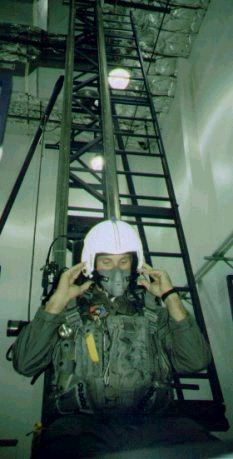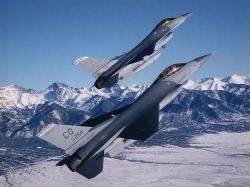| Blackout Modeling in Sim Design
by "Smoke." CO, Fighting 189th VFS Six Shooters |
||||
|
You are turning and burning in Falcon 4.0 or Total Air War or Fighter Squadron. Oh-oh, you've been pulling high Gs for too long and your field of vision is slowly closing down until all you see is a black screen. But is this a true representation of a fighter pilot's experience? I know that this article will bring me loads of criticism, but I believe that to get closer to a true "F-16 simulator" experience with a modern sim, one should turn the blackouts OFF. While I feel that the closer we get to real F-16 flight the better, there are many people who feel that a true experience can only be had by turning blackouts on. These virtual pilots have already made the mistake of assuming that the blackout modeling is correct. (We all know what the definition of assume is, right?) The modeling we are seeing with regard to blackouts isn't even close. Although there are those of you who were skeptical after the original release of this article, I have done further research and will continue to take the stand that the modeling we see is innaccurate. Now before you accuse me of heresy, please hear me out. Some Fighter History First let's go back in time when the F-16 was in it's theoretical design stage. We had learned from the Vietnam war that fighters of that era were getting too large and were cumbersome in a furball. Because of that we came to rely on missiles way too much, and a MIG-19 could give an F-4 all it wanted! In response, the design team at General Dynamics went to work on the concept of a maneuverable fighter that could dominate in any furball engagement. They realized that most fights occurred between 10k and 30k feet and at speeds under Mach 1 and that to dominate these dogfights an aircraft would have to handle high G loads. Hence the F-16 design work began (I know this is simplified, please bear with me.) To provide high-G tolerance the designers tilted the seat back 30 degrees from the vertical and raised the heel elevation six inches above the Vietnam era seats. These modifications reduced the effective distance between the heart and the brain which increased G tolerance by about two G's. By doing this they effectively gave the F-16 driver an edge over any other aircraft.
 Jarmo Lindberg of the Finnish Air Force. Take It to the Limit Where did they get the " 9-G" limit you ask? Well, it was taken through years of testing in the centrifuge that this was the maximum G load a pilot could sustain and still perform the mission. Obviously, the designers would not set the aircraft limit at a level that would black out pilots as much as they do in Falcon 4.0. |
 Furthermore, since that time systems have been added such as "Combat Edge." This system consists of a "Positive Pressure Breathing" oxygen regulator which forces air into the lungs to assist oxygen intake during straining maneuvers, coupled with a vest that limits how far your chest will expand (we don’t want to blow up like a balloon now do we?) Also, a few years back engineers increased the air flow output in the G suit to aid in response time and obtain near instantaneous inflation. Now, what does this all mean for us? For starters it allows us to take full advantage of the capabilities of the baddest weapons platform ever created: the Ferrari of fighters, the F-16 ! With these systems we can tame the beast and make it our own, and we can all become HeartBreakers and Grim Reapers. Asking the Question To bring all this into focus I spent some time with several of our pilots, both Air Force and Civilian Test Pilots, at LMTAS (Lockheed Martin Tactical Aircraft Systems) discussing the physiological effects of Hi-G's on our mortal bodies. I think you will find the answers interesting and varied. My first question to the U.S.A.F. pilots was directed to the extreme end of the equation. "Guys, in a 9G sustained turn what effects do you experience to your vision and how long can you sustain that?" After getting through all the comments of how much of a weenie the other one was, Major Don "Big Daddy" Mencl told me this: "If you prepare and do your L-1 maneuver (which is now called the AGSM - Anti G Strain Maneuver), you can sustain a 9-G pull for as long as you need to without any loss of vision." Wait a minute, what is an L-1 maneuver, some kind of "split-S?" I kidded. He laughed, "No it’s the tightening of your body and the controlled forced breathing technique in three to five second intervals that helps you maintain the blood in the upper body, thereby keeping the blood to the brain." Oh yeah, I remember doing it during my Hi-G experiences. Didn't know that was what it was called. I personally named it the "trying to crap the football maneuver." LOL. Anyway, Big Daddy went on to say that you can control how G's affect you by utilizing this method and by being in condition . . . and that means being in shape and current at experiencing G's. So let me condense some of this so everyone can remember: I'll call it our 9G check list. 1. Quick breath, hold, strain - crap the football. 2. Quick breath, hold, strain - CTFB (abbrev for ya) 3. Quick breath, hold, strain - CTFB You get the picture. Go to Part II
|
|||
|
Copyright © 1997 - 2000 COMBATSIM.COM, INC. All Rights Reserved. Last Updated May 4th, 1999 |
||||
